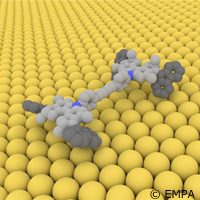A noiseless, emission-free car? Europeans are on the right track
Dutch and Swiss researchers have developed a four-wheel drive car that produces no noise and no emissions. Presented in the journal Nature, the study was funded in part by the MOLECULAR MOTORS ('Molecular motors - controlling movement at the nanoscale') project, which is supported through a European Research Council (ERC) Advanced Grant worth EUR 2.18 million under the EU's Seventh Framework Programme (FP7). The researchers say this prototype symbolises lightweight construction at its most extreme. Engines can transform chemical, thermal or electrical energy into kinetic energy to allow movement of goods from points A to B. In this same vein, Mother Nature does the same thing. Motor proteins like kinesin and the muscle protein actin perform this task. Researchers say these proteins usually glide along other proteins and 'burn' adenosine triphosphate (ATP). Scientists from the University of Groningen and the University of Twente in the Netherlands, as well as the Swiss Federal Laboratories for Materials Science and Technology (EMPA) and the University of Zurich in Switzerland developed this nano car that contains only one molecule and travels on four electrically driven wheels in an almost straight line over a copper surface. By synthesising a molecule from four rotating motor units, the team has brought Europe one step closer to the development of artificial nanoscale transport systems. 'To do this, our car needs neither rails nor petrol; it runs on electricity,' said EMPA researcher Karl-Heinz Ernst, who is also a professor at the University of Zurich. 'It must be the smallest electric car in the world - and it even comes with a four-wheel drive.' The challenge in developing this car is to improve its refuelling capacity. According to the researchers, because this car measures 4x2 nanometres, which is about 500 million times smaller than a Volkswagen Golf, it needs to be refilled with power after every half revolution of the wheels. This is made through the tip of a scanning tunnelling microscope (STM). Its molecular design also limits the wheels' turning ability; it can only turn in one direction. 'In other words, there's no reverse gear,' Professor Ernst explained. The researchers pointed out that based on its 'construction plan', the drive of the complex organic molecule functions in the following manner: after sublimating it onto a copper surface and positioning a STM tip over it and leaving a reasonable gap, a medium voltage of no less than 500 microvolts is applied. Electrons then 'tunnel' through the molecule, generating reversible structural changes in each of the four motor units. A cis-trans isomerisation emerges at a double bond. Both side groups tilt to pass each other and return to their original position. If all four wheels turn simultaneously, the car travels forward. After 10 STM simulations were performed, the researchers found that the molecule had moved 6 nanometres forward. 'The deviations from the predicted trajectory result from the fact that it is not at all a trivial matter to stimulate all four motor units at the same time,' Professor Ernst said.For more information, please visit: EMPA: http://www.empa.ch/ European Research Council (ERC): http://erc.europa.eu/
Countries
Netherlands

